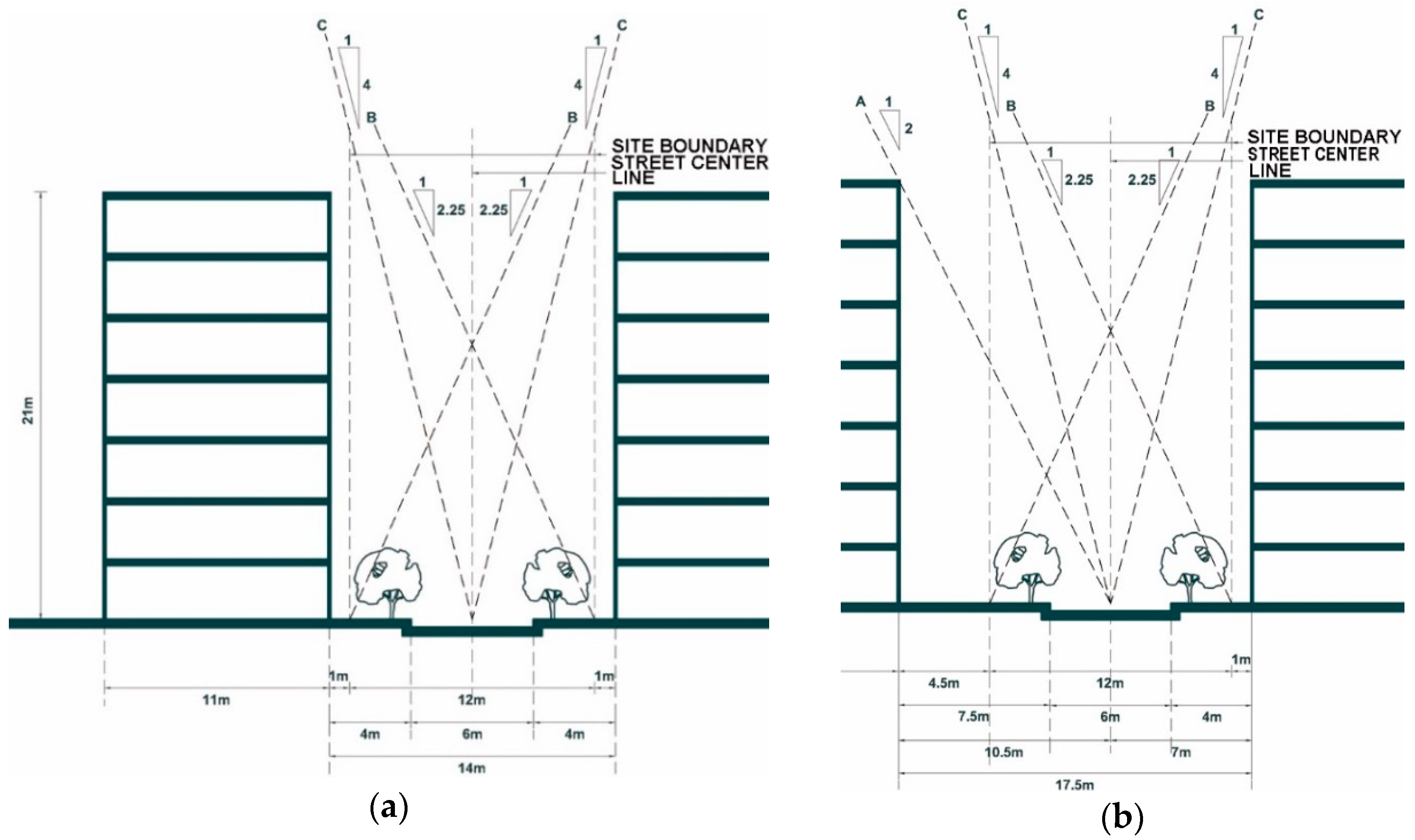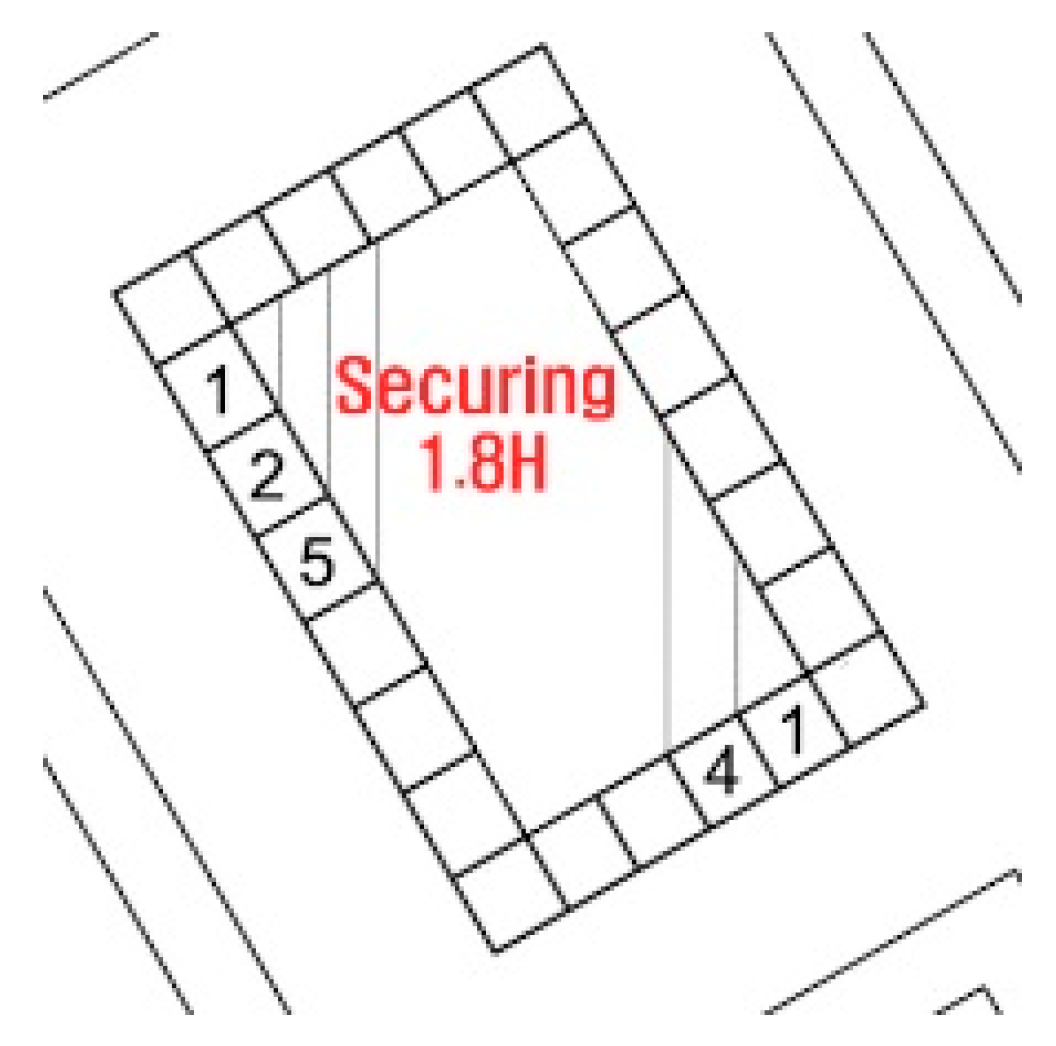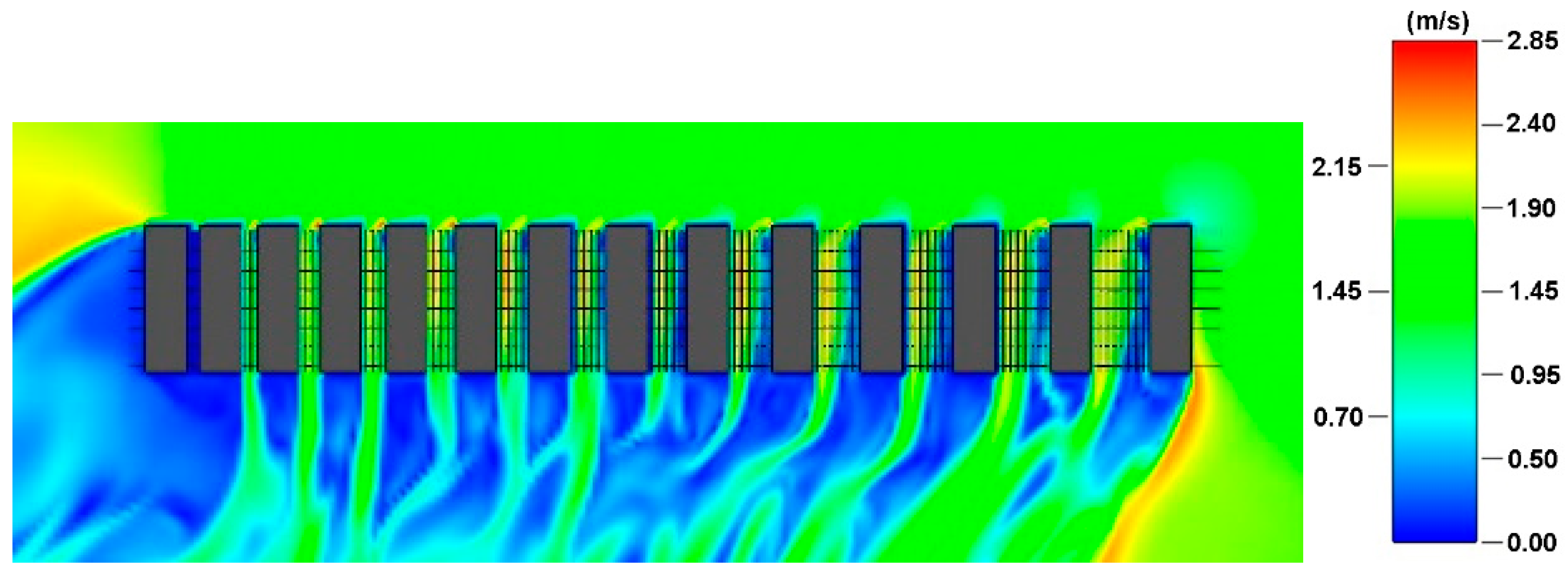1. Introduction
Identifying the appropriate housing type corresponding to the street structure of a city has been a critical task in designing residential buildings in South Korea since the 2000s. The search and contemplation of new types of collective housing have been driven by the awareness and reflection on problems arising from the uniformity of tower-type residential buildings created by conventional high-density and high-rise development, disconnect in the urban context due to the closed and insulated nature of the block unit structure, and disparity in the urban scenery, and the subsequent findings have been applied to the study and designs of perimeter block housing [
1]. Block unit housing is a building type that forms the premise of urban plot unit rearrangement projects based on the construction of double walls, which was legalized in 2012 as a form of small-scale gradual development; sustainable urban regeneration including block-unit housing rearrangement projects, or gradual housing area rearrangement projects [
2].
In particular, block-unit housing rearrangement projects operate based on the architectural model of mid-rise, high-density, street-oriented block housing with the floor area ratio of at least 200 percent, with the aim to redevelop conventional multi-household and multi-family density regions by each block unit, but the high building-to-land ratio and wall-to-building ratio may comprise unfavorable conditions in terms of daylight and ventilation, leading to the deterioration of the residential environment. Since the layout of street-oriented housing is designed in active correspondence with the surrounding streets, it may result in unfavorable orientations for certain residential units and create an imbalance of daylight between households due to self-shadows. In addition, an air-flow stagnation area may occur in the external space depending on the form of the unit mass, causing unfavorable natural ventilation. Accordingly, in order for perimeter block housing to be used as an alternative urban housing type, there needs to be a study on a design methodology that considers the day-lit environment and natural ventilation performance while securing density at a proper scale.
Previous studies on street-oriented housing include studies on the models and legal systems of small-scale block unit rearrangement projects, which mainly focus on simulations for development density and construction types according to mitigating conditions stipulated in the Building Act and the Housing Act [
3,
4]. In contrast, previous studies on day-lit environments of block unit collective housing include studies on day-lit environments of courtyard-type collective [
5,
6,
7,
8,
9,
10,
11]. The study by Kang, 2004 [
5] suggested a −30° azimuth angle as the optimum azimuth angle in an analysis to identify a favorable layout angle in day-lit aspects, and the study by Hwang, 2011 [
6] examined a marginal analysis of applying the current standard for distance between buildings to the context of block-type collective housing. The study by Kim, 2014 [
8,
9,
10] presented the methodology for mass formation using shadow characteristics in courtyard-type and street-oriented housing.
Meanwhile, there have been insufficient studies on the methodology for wind path planning in street-oriented housing, and the majority of previous studies focused on wind path planning to mitigate the formation of urban heat islands in flat-type or tower-type residential apartment complexes [
11,
12,
13,
14]. In particular, most of the studies placed an emphasis on comparing differences arising from types and layouts of residential buildings [
11,
13], or on strengthening air flow in lower parts of buildings where the air flow is prone to stagnation [
14,
15].
To implement eco-friendly planning in a mild climate region such as Seoul, which faces distinct seasonal changes and a broad annual temperature range, securing the right to daylight in the winter season is a precondition for reducing heating load, and the focal point is to increase thermal comfort in exterior spaces by planning wind paths with the aim to maximize natural ventilation. Accordingly, this study analyzed characteristics of day-lit environments in perimeter block housing of street systems with azimuth angles of 0 to 60°, which is the most common form of grid-type residential areas in Seoul, and by using shadow characteristics, investigated the form of residential buildings and the methodology for layout planning with the objective to meet the standard of two consecutive daylight hours on the winter solstice, which is a performance restriction prescribed in the Enforcement Decree of the Building Act. In addition, the study identified an air flow stagnation section by assessing the air flow of the exterior space of street-oriented block housing in consideration of day-lit environments, and examined a planning model that can enhance natural ventilation potential by activating the air flow of the exterior space.
The first phase of this study examined the existing preconditions of mass formation by applying legal standards for block-unit housing rearrangement projects to prominent urban organizations in grid-type residential areas of Seoul. In the second phase, a basic simulation was conducted for Seoul with the aim to examine a design methodology and validate its effectiveness with active consideration for daylighting and wind path from the initial stage of the design with regard to the form composition of street-oriented block housing. In the third phase, a design methodology for residential buildings was presented with the aim to optimize the day-lit environment of households within the blocks at azimuth angles of 0° and 60° based on properties and principles of shadows, without hindering two hours of continuous access to daylight on the exterior peripheral face of adjacent blocks. The fourth phase examined additional ways to adjust detailed masses so as to improve ventilation performance through a connection between the wind paths and exterior spaces of street-oriented block housing. For the assessment of environmental performance, in order to verify and validate the applied principles, a simulation was performed by using Autodesk Ecotect for daylight hours and Flow Design for wind blow patterns and wind velocity.
4. Discussion
4.1. Implications in Terms of the Day-Lit Environment
As seen in the simulation results, even if the day-lit environment of street-oriented block housing meets the architectural slant line restriction for daylight in the due north direction, masses measuring seven stories in height have a significant impact on the day-lit environment of neighboring blocks. In contrast, depending on the azimuth angle, certain parts even at heights higher than seven stories have no harmful impact on the day-lit environment of adjacent areas. As such, there is a need to consider a certain degree of flexibility in height restrictions, in cases where the exterior peripheral faces of adjacent blocks are not inhibited from securing two consecutive daylight hours. Considering that the architectural slant line restriction for daylight in the due north direction is intended to secure the right to daylight in areas further north than the corresponding area, as exemplified in this study, there is a need to reexamine the restriction of building height to seven stories in cases where the exterior peripheral faces of adjacent blocks are not inhibited from securing two consecutive daylight hours. Since there are mass formations that can minimize such an impact on the surroundings depending on the direction, the introduction of performance restrictions for securing two consecutive daylight hours, similar to that of collective housing, could be a reasonable measure.
In addition, in accordance with the revised enforcement decree of the Act on Rearrangement of Urban and Residential Environments and ordinances of local governments, it became possible to construct buildings with fewer than 15 stories. Therefore, it is necessary to consider the concept of introducing average building stories in terms of acceptable ranges and limits in the number of floors. In cases of introducing average building stories, building heights can be adjusted to ensure that parts exerting a significant impact on adjacent blocks, depending azimuth angles and block structure, are constructed as low-rises, while parts with less influence can be constructed as mid- or high-rises. However, since the basic concept of street-oriented block housing lies in creating residential buildings as urban constructions based on mid-rise and high-density development, there should be restrictions placed on density and height according to local conditions and city layouts, and it is worth exploring methods to promote adequate openness and a change in landscape under the condition that the fundamental right to daylight is secured.
4.2. Characteristics of Street-Oriented Block Housing and Wind Path Planning in Terms of the Wind Environment
The wind velocity ratio is defined as wind velocity within the complex divided by the velocity of the wind blowing toward the complex. The closer to 1 the wind velocity ratio is, the more likely it is that the wind velocity will be the same inside and outside of the complex. According to the study by A, the wind velocity ratio of the low-rise apartment ranged from 0.2 to 0.4, and that of the high-rise apartment ranged from 0.5 to 0.7. Overall, simulations show that the wind velocity ratio in street-oriented block housing ranged from 0.34 to 0.59, meaning that it is possible for wind path planning to be at a similar level to that of tower-type apartment housing.
In detail, the most important thing in the first phase of wind path planning for street-oriented housing is to design the wind inlet area in the prevailing wind direction to be open in consideration of the prevailing wind direction from the outset when designing residential building layouts. When residential buildings of the same form are placed in different locations, the alternative with the highest wind velocity ratio ranging from 0.05 to 0.1 was one in which the northeast corner was open for the prevailing wind direction with a continuous connection to exterior spaces. In the second phase, it is important to identify the wind shadow area generated according to the wind direction and mass shape, thus opening the lower part of the related wind shadow area and generating wind flow. In this study, a scheme with an opening (piloti) at a second-floor height in the lower part in the northeast corner was proven to be effective. Furthermore, an area with stagnant air flow despite a lower part opening could be improved in terms of the wind environment by creating a pressure difference resulting from the increased height of some masses. When a mass was heightened, using a staggered configuration was more effective, and in particular, the improvement in the wind velocity ratio was prominent at an azimuth angle of 0° with an optimized day-lit environment, along with a large difference in height between residential buildings.
4.3. Conclusions
This study proposed a design methodology for residential building layouts that is optimized in terms of the daylight environment with regards to street-oriented block housing, and examined a mass planning methodology based on environmental performance by applying a methodology for wind path planning [
19,
20,
21,
22]. In order for a household unit to receive two consecutive hours of daylight through the living room window on the winter solstice, the minimum distance between adjacent buildings at different azimuth angles should be secured, and masses should be configured to prevent daylight infringement due to self-shadows resulting from daylight interference between residential buildings. It was also confirmed that, through the use of shadow characteristics, the height of seven floors or higher can be secured according to the azimuth angle, and the location and orientation of residential buildings, while residential buildings within the said block could meet the standard of two consecutive daylight hours with minimized impact on neighboring blocks, along with development at a floor area ratio of about 200 percent.
The street-oriented housing in this study had a building coverage ratio of 20 to 30 percent, indicating that eco-friendly performance can be secured in such a housing type, with a wind velocity ratio ranging from 0.34 to 0.59. Despite being the same shape, it was shown that variations in residential building layouts made a difference to the wind velocity and wind flow patterns, which were impacted most by the extent of openness of the wind inlet area towards the prevailing wind direction, and the openness of the connection to the outside space. Therefore, the most important factor in wind path planning is to consider the prevailing wind direction from the outset in designing residential building layouts. In addressing air flow stagnation, the wind speed and wind flow could be improved through a lower part opening and adjustment of the height of some masses.
The above findings of this study suggest that a performance-based approach is necessary for the improvement of environmental performance in street-oriented block housing, in consideration of azimuth angles and the prevailing wind direction from the initial phase of planning. In addition, more research is needed on concepts such as average building stories and mixed density so that residential buildings are not subject to the height limit of seven stories but vary in the number of floors according to the location and orientation of residential buildings, insofar as the number of floors does not affect the right to daylight of a housing unit and adjacent housing units and generate rapid air flow.





























































































